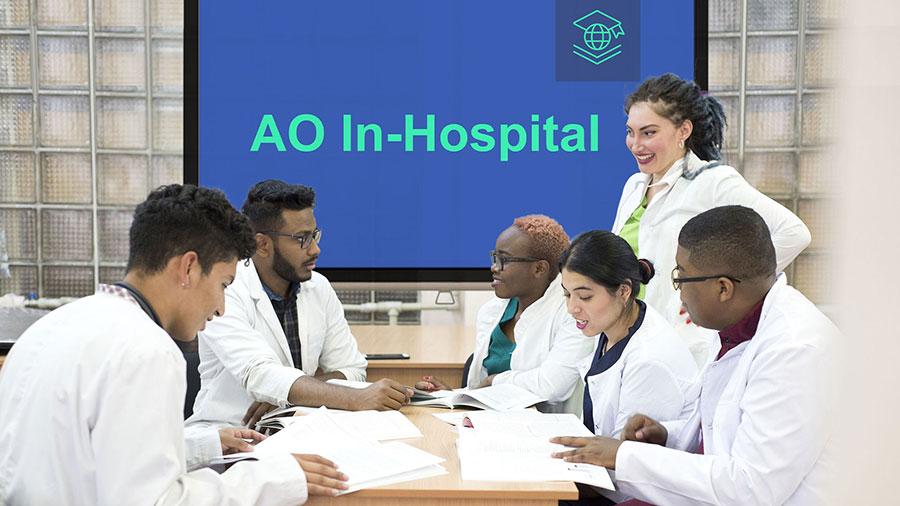AO In-Hospital widens offerings with new ‘Limb salvage versus amputation’ module

Once associated with high amputation rates, mangled extremities today can be salvaged, thanks to advances in evacuation, resuscitation, wound care, free tissue transfer, and internal fixation. The latest AO In-Hospital module, “Limb salvage versus amputation,” provides essential in-hospital training to inform the decision-making of junior orthopedic trauma surgeons, residents, and general trauma surgeons. It offers crucial insights to effectively support their decision-making processes.
A mangled extremity is a limb with injuries to at least three of the four systems: soft tissue, bone, nerves, and vessels. The two main treatment options are reconstruction or amputation. The new “Limb salvage versus amputation” module—now available on the AO In-Hospital dashboard—makes a valuable contribution to the AO’s mission of promoting excellence in patient care: It explores the variables related to the decision-making process for mangled extremity treatment, provides an understanding of each treatment method's advantages, disadvantages, and complications, and examines the therapeutic approach.
"AO In-Hospital is an effective online lecture platform for high-quality fracture treatment aimed at hospital staff,” said module editor Yong-Cheol Yoon explained. “Although many improvements in fracture treatment have been achieved through the AO courses, this new platform enhances patient care by offering innovative and diverse educational opportunities for those involved in fracture treatment.”
In developing the module content, Yoon and module authors Hoe-Jeong Chung, Won-Tae Cho, Beom-Soo Kim, and Eic Ju Lim aimed to provide learners with a proper understanding of mangled extremities and their treatment methods.
“We spent a month studying numerous papers and research on mangled extremities and received dedicated support from our peers,” Yoon explained. “While the outcome of our efforts may not be perfect, we hope it offers some assistance to medical professionals currently addressing issues with mangled extremities."
Learning objectives
At the end of this AO In-Hospital module, participants will be able to:
- Explore the variables guiding mangled extremity treatment decisions.
- Understand pros and cons of these treatment options.
- Outline the systematic approach for successful limb salvage surgery.
- Examine complications after salvage and amputation.
- Understand and compare the outcome of a mangled limb in detail.
Past AO Trauma International Board (AO TIB) Chairperson Kodi Kojima had high praise for the module’s editor and authors.
“My compliments and congratulations to the editor and authors team for this extremely well-done module with very clear pictures, perfect illustrations, and shared cases, and for their hard work and commitment to AO Trauma education,” he said.
Michael Baumgaertner, past AO TIB chairperson, also commended the work of the module’s editorial team.
“This is a wonderful addition to the program: a well organized, very balanced discussion of a very challenging clinical problem. The editor and authors have delivered clear lectures and remarkable clinical cases,” he said, adding that he additionally congratulates the AO staff who contributed the module’s look and feel.
Launched in 2022, AO In-Hospital is designed exclusively for AO Trauma faculty, providing them with a stress-free resource for organizing high-quality, regular, in-hospital training events. The free-of-charge, educational AO In-Hospital platform includes a library of ready-made, high-quality, relevant, and topical surgical training modules, all easily accessible to faculty at the touch of a finger, thanks to the easy-to-use dashboard. The new module further expands the array of highly relevant AO In-Hospital modules—including "Acute compartment syndrome,” “Polytrauma,” “Management of open fractures,” “Best practices in geriatric hip fractures,” and “Management of fracture-related infection”—and answers the needs of AO Faculty who have successfully deployed existing modules and have been waiting for new content.
Each of the six module includes:
- A pre-event assessment to identify the team’s educational needs
- Prereading material
- Didactic lectures
- Clinical case discussions
- Group discussions
- Optional practical exercises
- Post-event assessment and event reports to analyze the team's increase in knowledge
Upon completion of the pre- and post-event online assessments, participants receive
certificates of attendance.
